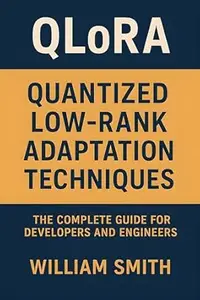QLoRA: Quantized Low-Rank Adaptation Techniques
English | August 20, 2025 | ASIN: B0FN6L7357 | 244 pages | EPUB (True) | 2.29 MB
English | August 20, 2025 | ASIN: B0FN6L7357 | 244 pages | EPUB (True) | 2.29 MB
"QLoRA: Quantized Low-Rank Adaptation Techniques"
"QLoRA: Quantized Low-Rank Adaptation Techniques" is the definitive guide to cutting-edge methods for making large neural networks adaptive, efficient, and scalable through the synergy of quantization and low-rank adaptation. The book opens with a thorough exploration of the challenges inherent in traditional fine-tuning approaches, emphasizing the urgent need for parameter-efficient strategies to keep pace with the growth of model sizes. Through a historical lens, it situates QLoRA at the intersection of classic adaptation techniques, providing foundational concepts and a clear structural roadmap for readers.
Diving deep into the theoretical and engineering underpinnings, the text elucidates the mathematics of quantized neural networks, low-rank matrix factorizations, and their profound implications for gradient stability, information retention, and model generalization. Readers are guided through canonical QLoRA architectures, advanced variants including hierarchical and multi-task scenarios, and practical workflows for efficient large-scale deployment—covering vital topics such as memory optimization, distributed training, mixed precision, and debugging. Extensive benchmarking studies, interpretability techniques, and visualizations help demystify the intricate trade-offs and real-world performance of QLoRA compared to alternative methods.
Beyond technical mastery, the book addresses pressing concerns of security, privacy, fairness, and compliance, empowering practitioners to deploy QLoRA responsibly across domains from NLP and multimodal AI to edge and federated learning. Forward-thinking applications and research trajectories discussed in the final chapters position QLoRA as pivotal to sustainable, high-impact, and trustworthy AI—equipping researchers, engineers, and practitioners alike with the insights and tools to redefine the future of model adaptation.



